2009 BMW 328I XDRIVE SPORTS WAGON fuel pressure
[x] Cancel search: fuel pressurePage 73 of 268
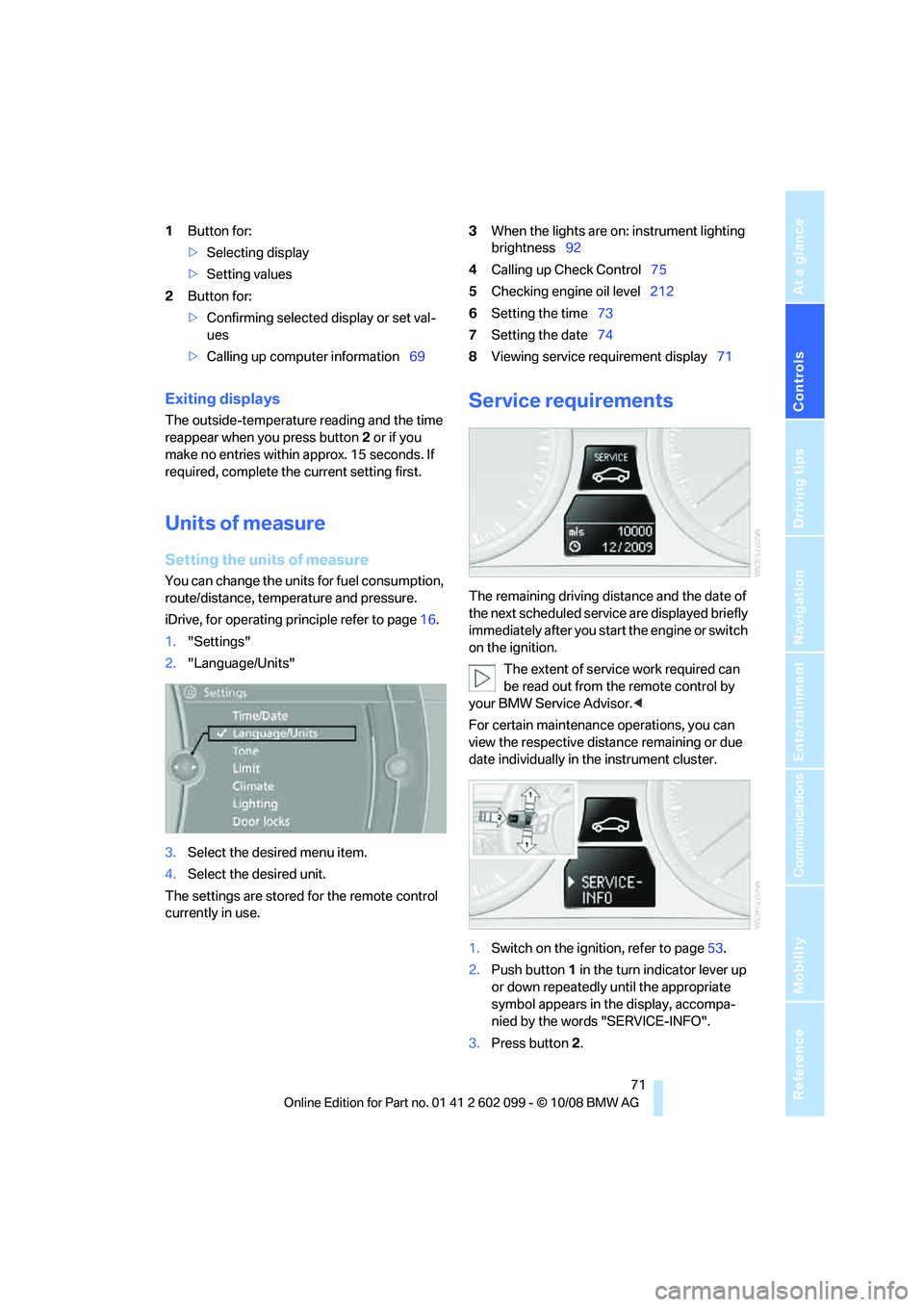
Controls
71Reference
At a glance
Driving tips
Communications
Navigation
Entertainment
Mobility
1Button for:
>Selecting display
> Setting values
2 Button for:
>Confirming selected display or set val-
ues
> Calling up computer information 693
When the lights are on: instrument lighting
brightness 92
4 Calling up Check Control 75
5 Checking engine oil level 212
6 Setting the time 73
7 Setting the date 74
8 Viewing service requirement display 71
Exiting displays
The outside-temperature reading and the time
reappear when you press button 2 or if you
make no entries within approx. 15 seconds. If
required, complete the current setting first.
Units of measure
Setting the units of measure
You can change the units for fuel consumption,
route/distance, temperature and pressure.
iDrive, for operating principle refer to page 16.
1. "Settings"
2. "Language/Units"
3. Select the desired menu item.
4. Select the desired unit.
The settings are stored for the remote control
currently in use.
Service requirements
The remaining driving dist ance and the date of
the next scheduled service are displayed briefly
immediately after you start the engine or switch
on the ignition.
The extent of service work required can
be read out from th e remote control by
your BMW Service Advisor. <
For certain maintenance operations, you can
view the respective distance remaining or due
date individually in the instrument cluster.
1. Switch on the ignition, refer to page 53.
2. Push button 1 in the turn indicator lever up
or down repeatedly until the appropriate
symbol appears in the display, accompa-
nied by the words "SERVICE-INFO".
3. Press button 2.
ba8_E9091_cic.book Seite 71 Mittwoch, 29. Oktober 2008 2:59 14
Page 89 of 268
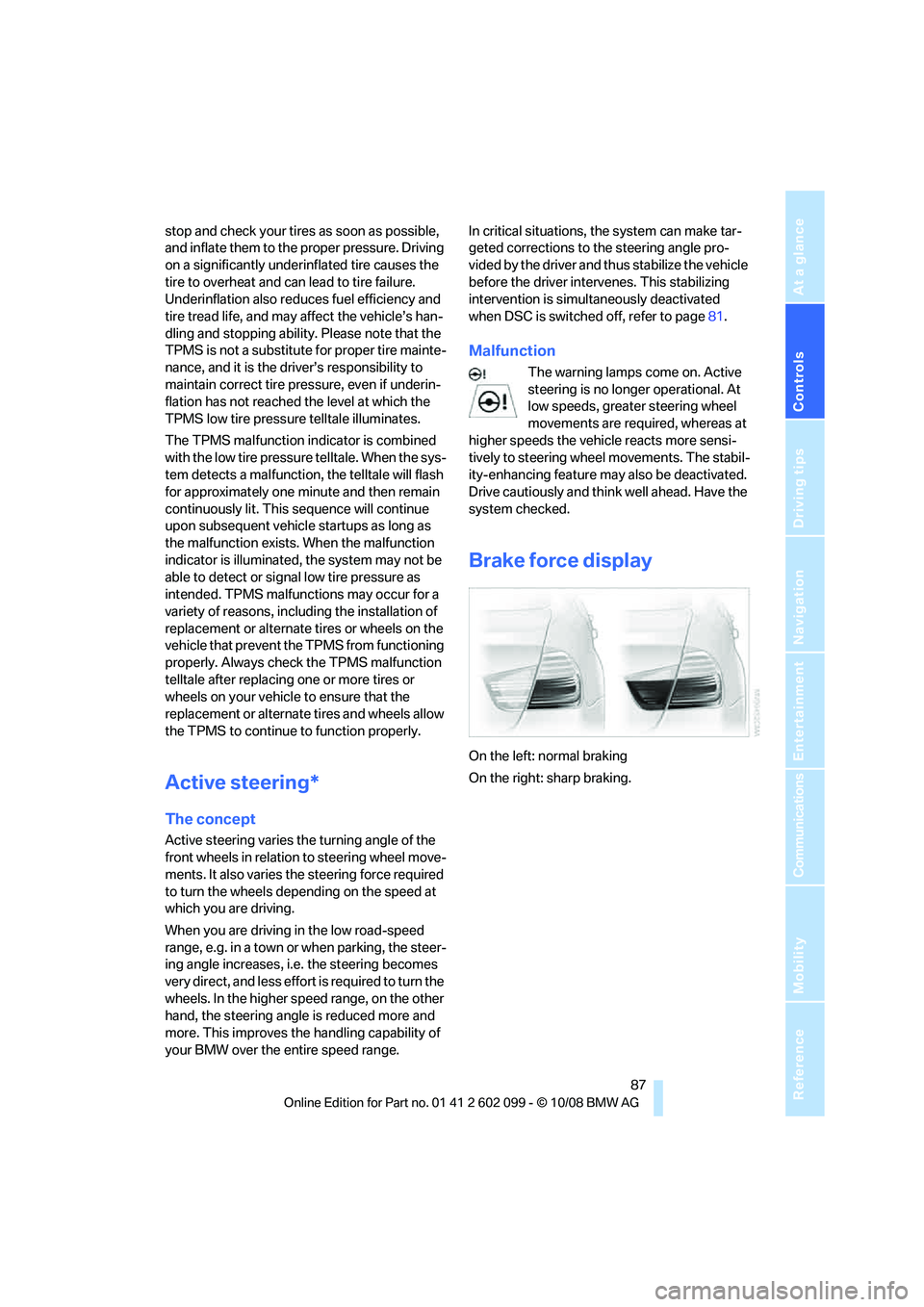
Controls
87Reference
At a glance
Driving tips
Communications
Navigation
Entertainment
Mobility
stop and check your tires as soon as possible,
and inflate them to the proper pressure. Driving
on a significantly underinflated tire causes the
tire to overheat and can lead to tire failure.
Underinflation also redu ces fuel efficiency and
tire tread life, and may affect the vehicle’s han-
dling and stopping ability. Please note that the
TPMS is not a substitute for proper tire mainte-
nance, and it is the driver’s responsibility to
maintain correct tire pressure, even if underin-
flation has not reached the level at which the
TPMS low tire pressure telltale illuminates.
The TPMS malfunction indicator is combined
with the low tire pressure telltale. When the sys-
tem detects a malfunction, the telltale will flash
for approximately one minute and then remain
continuously lit. This sequence will continue
upon subsequent vehicle startups as long as
the malfunction exists. When the malfunction
indicator is illuminated, the system may not be
able to detect or signal low tire pressure as
intended. TPMS malfunctions may occur for a
variety of reasons, including the installation of
replacement or alternate tires or wheels on the
vehicle that prevent the TPMS from functioning
properly. Always check the TPMS malfunction
telltale after replacing one or more tires or
wheels on your vehicle to ensure that the
replacement or alternate tires and wheels allow
the TPMS to continue to function properly.
Active steering*
The concept
Active steering varies the turning angle of the
front wheels in relation to steering wheel move-
ments. It also varies the steering force required
to turn the wheels depending on the speed at
which you are driving.
When you are driving in the low road-speed
range, e.g. in a town or when parking, the steer-
ing angle increases, i.e. the steering becomes
very direct, and less effort is required to turn the
wheels. In the higher speed range, on the other
hand, the steering angle is reduced more and
more. This improves the handling capability of
your BMW over the entire speed range. In critical situations,
the system can make tar-
geted corrections to the steering angle pro-
vided by the driver and thus stabilize the vehicle
before the driver inte rvenes. This stabilizing
intervention is simult aneously deactivated
when DSC is switched off, refer to page 81.
Malfunction
The warning lamps come on. Active
steering is no longer operational. At
low speeds, greater steering wheel
movements are required, whereas at
higher speeds the vehicle reacts more sensi-
tively to steering wheel movements. The stabil-
ity-enhancing feature may also be deactivated.
Drive cautiously and thin k well ahead. Have the
system checked.
Brake force display
On the left: normal braking
On the right: sharp braking.
ba8_E9091_cic.book Seite 87 Mittwoch, 29. Oktober 2008 2:59 14
Page 116 of 268
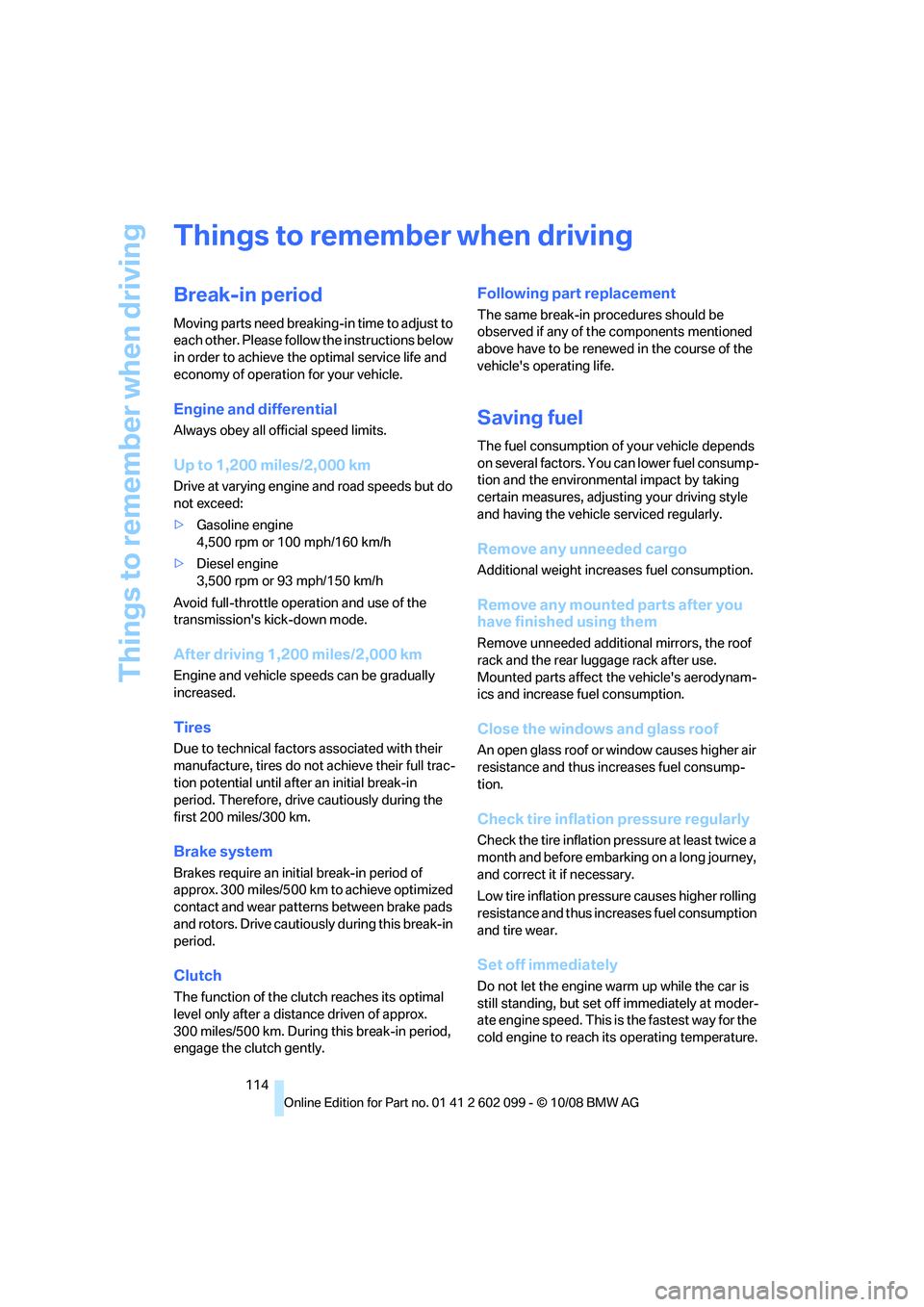
Things to remember when driving
114
Things to remember when driving
Break-in period
Moving parts need breaking-in time to adjust to
each other. Please follow the instructions below
in order to achieve the optimal service life and
economy of operation for your vehicle.
Engine and differential
Always obey all official speed limits.
Up to 1,200 miles/2,000 km
Drive at varying engine and road speeds but do
not exceed:
> Gasoline engine
4,500 rpm or 100 mph/160 km/h
> Diesel engine
3,500 rpm or 93 mph/150 km/h
Avoid full-throttle operation and use of the
transmission's kick-down mode.
After driving 1,200 miles/2,000 km
Engine and vehicle speeds can be gradually
increased.
Tires
Due to technical factors associated with their
manufacture, tires do no t achieve their full trac-
tion potential until afte r an initial break-in
period. Therefore, drive cautiously during the
first 200 miles/300 km.
Brake system
Brakes require an initial break-in period of
approx. 300 miles/500 km to achieve optimized
contact and wear patterns between brake pads
and rotors. Drive cautiously during this break-in
period.
Clutch
The function of the clut ch reaches its optimal
level only after a distan ce driven of approx.
300 miles/500 km. During this break-in period,
engage the clutch gently.
Following part replacement
The same break-in procedures should be
observed if any of the components mentioned
above have to be renewe d in the course of the
vehicle's operating life.
Saving fuel
The fuel consumption of your vehicle depends
on several factors. You can lower fuel consump-
tion and the environmental impact by taking
certain measures, adjusting your driving style
and having the vehicle serviced regularly.
Remove any unneeded cargo
Additional weight incr eases fuel consumption.
Remove any mounted parts after you
have finished using them
Remove unneeded additional mirrors, the roof
rack and the rear luggage rack after use.
Mounted parts affect th e vehicle's aerodynam-
ics and increase fuel consumption.
Close the windows and glass roof
An open glass roof or window causes higher air
resistance and thus increases fuel consump-
tion.
Check tire inflation pressure regularly
Check the tire inflation pr essure at least twice a
month and before embarking on a long journey,
and correct it if necessary.
Low tire inflation pressure causes higher rolling
resistance and thus increases fuel consumption
and tire wear.
Set off immediately
Do not let the engine wa rm up while the car is
still standing, but set off immediately at moder-
ate engine speed. This is the fastest way for the
cold engine to reach its operating temperature.
ba8_E9091_cic.book Seite 114 Mittwoch, 29. Oktober 2008 2:59 14
Page 212 of 268
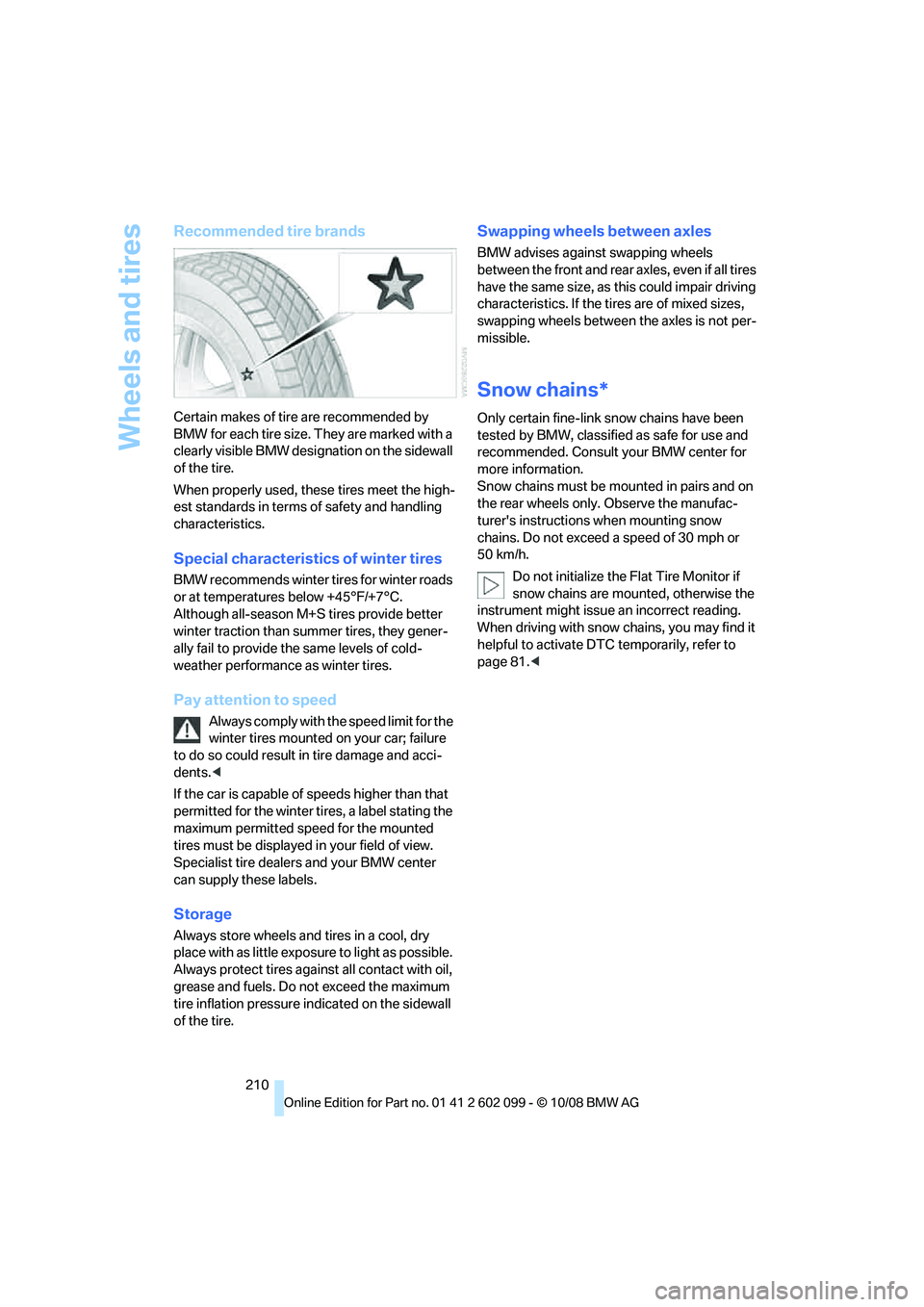
Wheels and tires
210
Recommended tire brands
Certain makes of tire are recommended by
BMW for each tire size. They are marked with a
clearly visible BMW designation on the sidewall
of the tire.
When properly used, these tires meet the high-
est standards in terms of safety and handling
characteristics.
Special characteristics of winter tires
BMW recommends winter tires for winter roads
or at temperatures below +45°F/+7°C.
Although all-season M+ S tires provide better
winter traction than summer tires, they gener-
ally fail to provide the same levels of cold-
weather performance as winter tires.
Pay attention to speed
Always comply with the speed limit for the
winter tires mounted on your car; failure
to do so could result in tire damage and acci-
dents. <
If the car is capable of speeds higher than that
permitted for the winter ti res, a label stating the
maximum permitted speed for the mounted
tires must be displayed in your field of view.
Specialist tire dealers and your BMW center
can supply these labels.
Storage
Always store wheels and tires in a cool, dry
place with as little exposure to light as possible.
Always protect tires agains t all contact with oil,
grease and fuels. Do not exceed the maximum
tire inflation pressure indicated on the sidewall
of the tire.
Swapping wheels between axles
BMW advises against swapping wheels
between the front and rear axles, even if all tires
have the same size, as th is could impair driving
characteristics. If the tires are of mixed sizes,
swapping wheels betwee n the axles is not per-
missible.
Snow chains*
Only certain fine-link sn ow chains have been
tested by BMW, classified as safe for use and
recommended. Consult your BMW center for
more information.
Snow chains must be mounted in pairs and on
the rear wheels only. Observe the manufac-
turer's instructions when mounting snow
chains. Do not exceed a speed of 30 mph or
50 km/h.
Do not initialize the Flat Tire Monitor if
snow chains are mounted, otherwise the
instrument might issue an incorrect reading.
When driving with snow chains, you may find it
helpful to activate DTC temporarily, refer to
page 81. <
ba8_E9091_cic.book Seite 210 Mittwoch, 29. Oktober 2008 2:59 14
Page 221 of 268
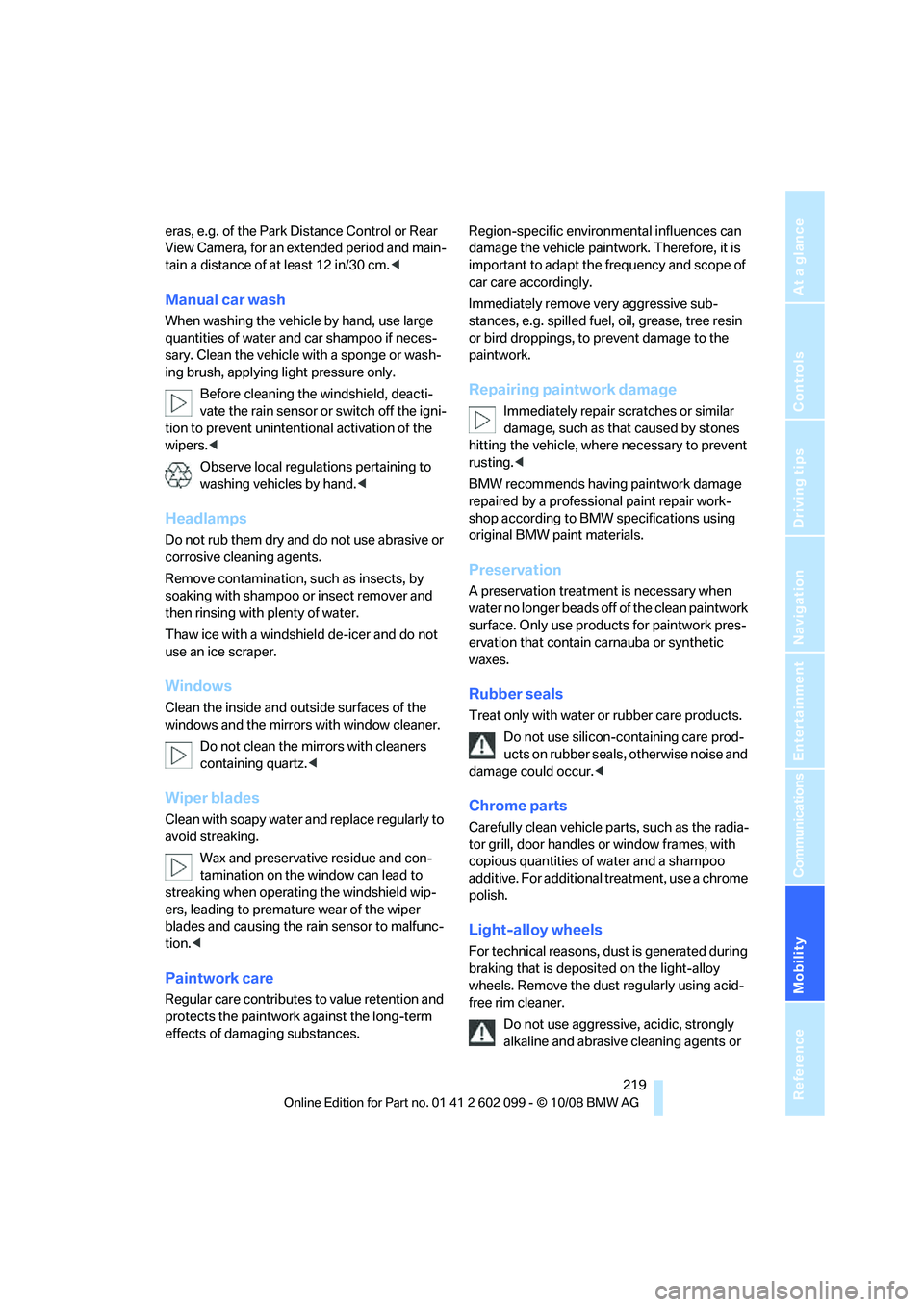
Mobility
219Reference
At a glance
Controls
Driving tips
Communications
Navigation
Entertainment
eras, e.g. of the Park Distance Control or Rear
View Camera, for an extended period and main-
tain a distance of at least 12 in/30 cm.<
Manual car wash
When washing the vehicle by hand, use large
quantities of water and car shampoo if neces-
sary. Clean the vehicle with a sponge or wash-
ing brush, applying light pressure only.
Before cleaning the windshield, deacti-
vate the rain sensor or switch off the igni-
tion to prevent unintent ional activation of the
wipers. <
Observe local regulations pertaining to
washing vehicles by hand. <
Headlamps
Do not rub them dry and do not use abrasive or
corrosive cleaning agents.
Remove contamination, such as insects, by
soaking with shampoo or insect remover and
then rinsing with plenty of water.
Thaw ice with a windshield de-icer and do not
use an ice scraper.
Windows
Clean the inside and outside surfaces of the
windows and the mirrors with window cleaner.
Do not clean the mirrors with cleaners
containing quartz. <
Wiper blades
Clean with soapy water and replace regularly to
avoid streaking.
Wax and preservative residue and con-
tamination on the wi ndow can lead to
streaking when operating the windshield wip-
ers, leading to premature wear of the wiper
blades and causing the ra in sensor to malfunc-
tion. <
Paintwork care
Regular care contributes to value retention and
protects the paintwork against the long-term
effects of damaging substances. Region-specific environmental influences can
damage the vehicle paintwork. Therefore, it is
important to adapt the frequency and scope of
car care accordingly.
Immediately remove ve
ry aggressive sub-
stances, e.g. spilled fuel, oil, grease, tree resin
or bird droppings, to prevent damage to the
paintwork.
Repairing paintwork damage
Immediately repair scratches or similar
damage, such as that caused by stones
hitting the vehicle, wher e necessary to prevent
rusting. <
BMW recommends having paintwork damage
repaired by a profession al paint repair work-
shop according to BMW specifications using
original BMW paint materials.
Preservation
A preservation treatmen t is necessary when
water no longer beads off of the clean paintwork
surface. Only use products for paintwork pres-
ervation that contain carnauba or synthetic
waxes.
Rubber seals
Treat only with water or rubber care products.
Do not use silicon-containing care prod-
ucts on rubber seals, otherwise noise and
damage could occur. <
Chrome parts
Carefully clean vehicle parts, such as the radia-
tor grill, door handles or window frames, with
copious quantities of water and a shampoo
additive. For additional treatment, use a chrome
polish.
Light-alloy wheels
For technical reasons, du st is generated during
braking that is deposi ted on the light-alloy
wheels. Remove the dust regularly using acid-
free rim cleaner.
Do not use aggressive, acidic, strongly
alkaline and abrasive cleaning agents or
ba8_E9091_cic.book Seite 219 Mittwoch, 29. Oktober 2008 2:59 14
Page 252 of 268
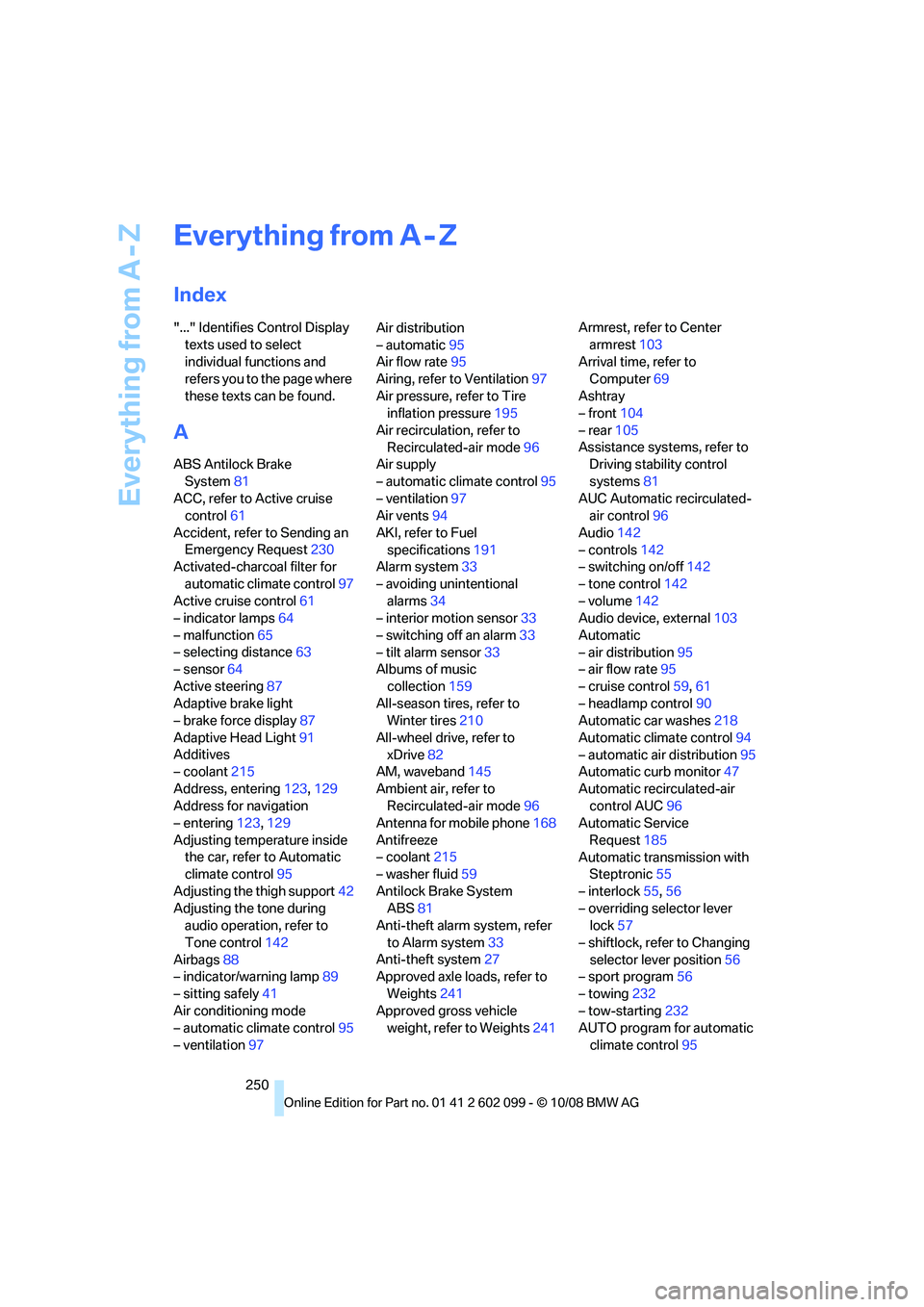
Everything from A - Z
250
Everything from A - Z
Index
"..." Identifies Control Display texts used to select
individual functions and
refers you to the page where
these texts can be found.
A
ABS Antilock Brake System 81
ACC, refer to Active cruise control 61
Accident, refer to Sending an Emergency Request 230
Activated-charcoal filter for
automatic climate control 97
Active cruise control 61
– indicator lamps 64
– malfunction 65
– selecting distance 63
– sensor 64
Active steering 87
Adaptive brake light
– brake force display 87
Adaptive Head Light 91
Additives
– coolant 215
Address, entering 123,129
Address for navigation
– entering 123,129
Adjusting temperature inside the car, refer to Automatic
climate control 95
Adjusting the thigh support 42
Adjusting the tone during audio operation, refer to
Tone control 142
Airbags 88
– indicator/warning lamp 89
– sitting safely 41
Air conditioning mode
– automatic climate control 95
– ventilation 97 Air distribution
– automatic
95
Air flow rate 95
Airing, refer to Ventilation 97
Air pressure, refer to Tire inflation pressure 195
Air recirculation, refer to Recirculated-air mode 96
Air supply
– automatic climate control 95
– ventilation 97
Air vents 94
AKI, refer to Fuel specifications 191
Alarm system 33
– avoiding unintentional alarms 34
– interior motion sensor 33
– switching off an alarm 33
– tilt alarm sensor 33
Albums of music
collection 159
All-season tires, refer to Winter tires 210
All-wheel drive, refer to xDrive 82
AM, waveband 145
Ambient
air, refer to
Recirculated-air mode 96
Antenna for mobile phone 168
Antifreeze
– coolant 215
– washer fluid 59
Antilock Brake System ABS 81
Anti-theft alarm system, refer
to Alarm system 33
Anti-theft system 27
Approved axle loads, refer to
Weights 241
Approved gross vehicle weight, refer to Weights 241Armrest, refer to Center
armrest 103
Arrival time, refer to
Computer 69
Ashtray
– front 104
– rear 105
Assistance systems, refer to Driving stability control
systems 81
AUC Automatic recirculated- air control 96
Audio 142
– controls 142
– switching on/off 142
– tone control 142
– volume 142
Audio device, external 103
Automatic
– air distribution 95
– air flow rate 95
– cruise control 59,61
– headlamp control 90
Automatic car washes 218
Automatic climate control 94
– automatic air distribution 95
Automatic curb monitor 47
Automatic recirculated-air control AUC 96
Automatic Service
Request 185
Automatic transmission with Steptronic 55
– interlock 55,56
– overriding selector lever lock 57
– shiftlock, refer to Changing selector lever position 56
– sport program 56
– towing 232
– tow-starting 232
AUTO program for automatic
climate control 95
ba8_E9091_cic.book Seite 250 Mittwoch, 29. Oktober 2008 2:59 14
Page 257 of 268
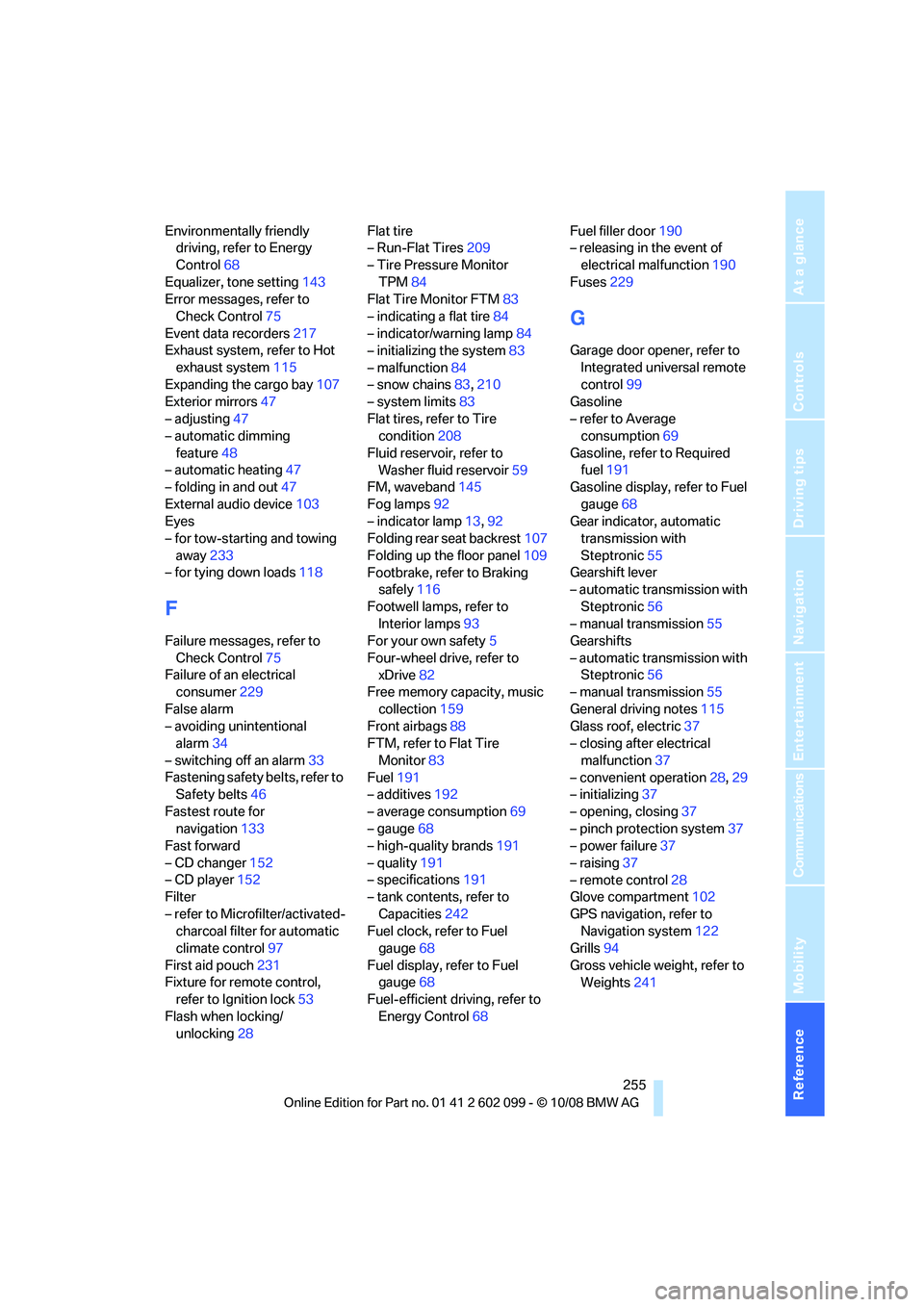
Reference 255
At a glance
Controls
Driving tips
Communications
Navigation
Entertainment
Mobility
Environmentally friendly driving, refer to Energy
Control 68
Equalizer, tone setting 143
Error messages, refer to
Check Control 75
Event data recorders 217
Exhaust system, refer to Hot
exhaust system 115
Expanding the cargo bay 107
Exterior mirrors 47
– adjusting 47
– automatic dimming
feature 48
– automatic heating 47
– folding in and out 47
External audio device 103
Eyes
– for tow-starting and towing
away 233
– for tying down loads 118
F
Failure messages, refer to
Check Control 75
Failure of an electrical consumer 229
False alarm
– avoiding unintentional alarm 34
– switching off an alarm 33
Fastening safety belts, refer to Safety belts 46
Fastest route for navigation 133
Fast forward
– CD changer 152
– CD player 152
Filter
– refer to Microfilter/activated- charcoal filter for automatic
climate control 97
First aid pouch 231
Fixture for remote control, refer to Ignition lock 53
Flash when locking/ unlocking 28 Flat tire
– Run-Flat Tires
209
– Tire Pressure Monitor TPM 84
Flat Tire Monitor FTM 83
– indicating a flat tire 84
– indicator/warning lamp 84
– initializing the system 83
– malfunction 84
– snow chains 83,210
– system limits 83
Flat tires, refer to Tire condition 208
Fluid reservoir, refer to Washer fluid reservoir 59
FM, waveband 145
Fog lamps 92
– indicator lamp 13,92
Folding rear seat backrest 107
Folding up the floor panel 109
Footbrake, refer to Braking safely 116
Footwell lamps, refer to Interior lamps 93
For your own safety 5
Four-wheel drive, refer to xDrive 82
Free memory capacity, music
collection 159
Front airbags 88
FTM, refer to Flat Tire
Monitor 83
Fuel 191
– additives 192
– average consumption 69
– gauge 68
– high-qu
ality brands 191
– quality 191
– specifications 191
– tank contents, refer to
Capacities 242
Fuel clock, refer to Fuel gauge 68
Fuel display, refer to Fuel gauge 68
Fuel-efficient driving, refer to
Energy Control 68 Fuel filler door
190
– releasing in the event of
electrical malfunction 190
Fuses 229
G
Garage door opener, refer to
Integrated universal remote
control 99
Gasoline
– refer to Average consumption 69
Gasoline, refer to Required
fuel 191
Gasoline display, refer to Fuel
gauge 68
Gear indicator, automatic transmission with
Steptronic 55
Gearshift lever
– automatic transmission with
Steptronic 56
– manual transmission 55
Gearshifts
– automatic transmission with Steptronic 56
– manual transmission 55
General driving notes 115
Glass roof, electric 37
– closing after electrical
malfunction 37
– convenient operation 28,29
– initializing 37
– opening, closing 37
– pinch protection system 37
– power failure 37
– raising 37
– remote control 28
Glove compartment 102
GPS navigation, refer to Navigation system 122
Grills 94
Gross vehicle weight, refer to Weights 241
ba8_E9091_cic.book Seite 255 Mittwoch, 29. Oktober 2008 2:59 14
Page 260 of 268
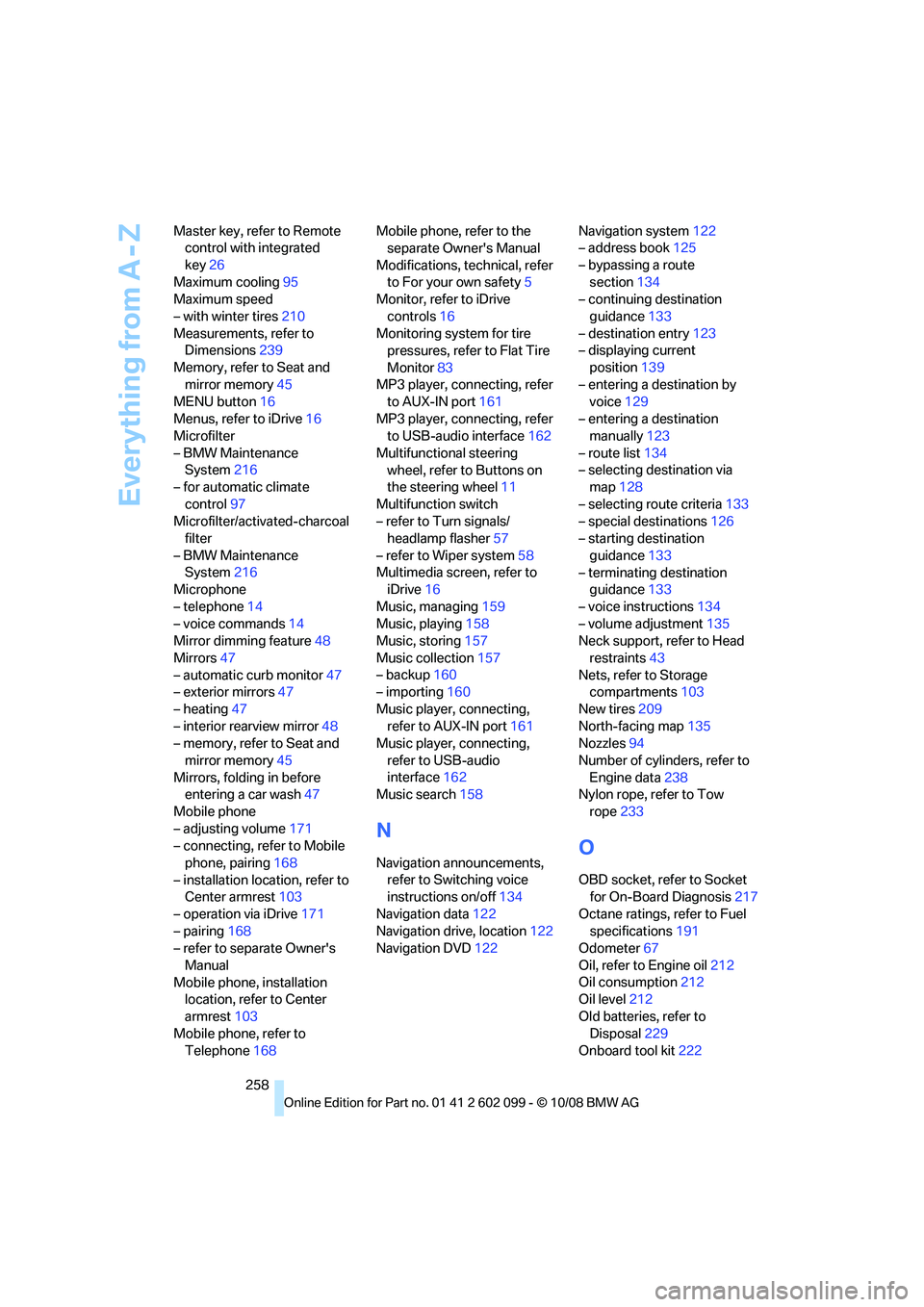
Everything from A - Z
258
Master key, refer to Remote
control with integrated
key 26
Maximum cooling 95
Maximum speed
– with winter tires 210
Measurements, refer to Dimensions 239
Memory, refer to Seat and mirror memory 45
MENU button 16
Menus, refer to iDrive 16
Microfilter
– BMW Maintenance System 216
– for automatic climate
control 97
Microfilter/activated-charcoal filter
– BMW Maintenance System 216
Microphone
– telephone 14
– voice commands 14
Mirror dimming feature 48
Mirrors 47
– automatic curb monitor 47
– exterior mirrors 47
– heating 47
– interior rearview mirror 48
– memory, refer to Seat and
mirror memory 45
Mirrors, folding in before entering a car wash 47
Mobile phone
– adjusting volume 171
– connecting, refer to Mobile
phone, pairing 168
– installation location, refer to Center armrest 103
– operation via iDrive 171
– pairing 168
– refer to separate Owner's
Manual
Mobile phone, installation location, refer to Center
armrest 103
Mobile phone, refer to Telephone 168 Mobile phone, refer to the
separate Owner's Manual
Modifications, technical, refer to For your own safety 5
Monitor, refer to iDrive
controls 16
Monitoring system for tire pressures, refer to Flat Tire
Monitor 83
MP3 player, connecting, refer to AUX-IN port 161
MP3 player, connecting, refer to USB-audio interface 162
Multifunctional steering wheel, refer to Buttons on
the steering wheel 11
Multifunction switch
– refer to Turn signals/ headlamp flasher 57
– refe
r to Wiper system 58
Multimedia screen, refer to iDrive 16
Music, managing 159
Music, playing 158
Music, storing 157
Music collection 157
– backup 160
– importing 160
Music player, connecting, refer to AUX-IN port 161
Music player, connecting,
refer to USB-audio
interface 162
Music search 158
N
Navigation announcements,
refer to Switching voice
instructions on/off 134
Navigation data 122
Navigation drive, location 122
Navigation DVD 122 Navigation system
122
– address book 125
– bypassing a route section 134
– continuing destination
guidance 133
– destination entry 123
– displaying current
position 139
– entering a destination by voice 129
– entering a destination manually 123
– route list 134
– selecting destination via map 128
– selecting route criteria 133
– special destinations 126
– starting destination
guidance 133
– terminating destination guidance 133
– voice instructions 134
– volume adjustment 135
Neck support, refer to Head
restraints 43
Nets, refer to Storage compartments 103
New tires 209
North-facing map 135
Nozzles 94
Number of cylinders, refer to Engine data 238
Nylon rope, refer to Tow
rope 233O
OBD socket, refer to Socket
for On-Board Diagnosis 217
Octane ratings, refer to Fuel specifications 191
Odometer 67
Oil, refer to Engine oil 212
Oil consumption 212
Oil level 212
Old batteries, refer to Disposal 229
Onboard tool kit 222
ba8_E9091_cic.book Seite 258 Mittwoch, 29. Oktober 2008 2:59 14